On the Performance of Small-Scale Horizontal Axis Tidal Current Turbines. Part 1: One Single Turbine
Abstract
1. Introduction
2. Numerical Procedure
2.1. Computational Domain and Boundary Condition
2.2. Mesh Generation
2.3. CFD Analysis
3. HATCT Performance Indicators
4. Results and Discussion
4.1. Model Validation
4.2. Pressure Contours
4.3. Performance Exploration: TKE, Cut-in-Speed and Streamlines Approaches
4.4. Performance Indicators: Torque, CT and CP Evaluation
4.5. Performance Comparison with Some Existing Literature
5. Conclusions
Author Contributions
Funding
Conflicts of Interest
Nomenclature
| V | Free stream velocity(m/s) |
| A | Rotor Area(m2) |
| R | Rotor radius(m) |
| ρ | Density(kg/m3) |
| ω | Angular velocity(rpm) |
| t | Torque(N.m) |
| T | Thrust(N) |
| Ct | Coefficient of torque |
| CT | Coefficient of thrust |
| CP | Power coefficient |
| TKE | Turbulence Kinetic Energy |
| TSR | Tip speed ratio |
| LDR | Lift to Drag ratio |
References
- Zhang, X.; Yang, C.; Li, S. Influence of Low-Level Jet intensity on aerodynamic loads of horizontal axis wind turbine rotor. Eng. Appl. Comput. Fluid Mech. 2019, 13, 300–308. [Google Scholar] [CrossRef]
- Yang, P.; Xiang, J.; Fang, F.; Pain, C. A fidelity fluid-structure interaction model for vertical axis tidal turbines in turbulence flows. Appl. Energy 2019, 236, 465–477. [Google Scholar] [CrossRef]
- Nabipour, N.; Mosavi, A.; Hajnal, E.; Nadai, L.; Shamshirband, S.; Chau, K.-W. Modeling climate change impact on wind power resources using adaptive neuro-fuzzy inference system. Eng. Appl. Comput. Fluid Mech. 2020, 14, 491–506. [Google Scholar] [CrossRef]
- Lee, J.H.; Park, S.; Kim, D.H.; Rhee, S.H.; Kim, M.-C. Computational methods for performance analysis of horizontal axis tidal stream turbines. Appl. Energy 2012, 98, 512–523. [Google Scholar] [CrossRef]
- Chen, W.-H.; Chen, C.-Y.; Huang, C.-Y.; Hwang, C.-J. Power output analysis and optimization of two straight-bladed vertical-axis wind turbines. Appl. Energy 2017, 185, 223–232. [Google Scholar] [CrossRef]
- Alipour, R.; Najarian, F. A FEM study of explosive welding of double layer tubes. World Acad. Sci. Eng. Technol. 2011, 73, 954–956. [Google Scholar]
- Draycott, S.; Nambiar, A.; Sellar, B.; Davey, T.; Venugopal, V. Assessing extreme loads on a tidal turbine using focused wave groups in energetic currents. Renew. Energy 2019, 135, 1013–1024. [Google Scholar] [CrossRef]
- Alipour, R.; Nejad, A.F. Creep behaviour characterisation of a ferritic steel alloy based on the modified theta-projection data at an elevated temperature. Int. J. Mater. Res. 2016, 107, 406–412. [Google Scholar] [CrossRef]
- Draycott, S.; Payne, G.; Steynor, J.; Nambiar, A.; Sellar, B.; Venugopal, V. An experimental investigation into non-linear wave loading on horizontal axis tidal turbines. J. Fluids Struct. 2019, 84, 199–217. [Google Scholar] [CrossRef]
- Estate, C. UK Wave and Tidal Key Resource Areas Project—Summary Report; Crown Estate: London, UK, 2012. [Google Scholar]
- Meana-Fernández, A.; Fernández Oro, J.M.; Argüelles Díaz, K.M.; Galdo-Vega, M.; Velarde-Suárez, S. Application of Richardson extrapolation method to the CFD simulation of vertical-axis wind turbines and analysis of the flow field. Eng. Appl. Comput. Fluid Mech. 2019, 13, 359–376. [Google Scholar] [CrossRef]
- Yan, J.; Deng, X.; Korobenko, A.; Bazilevs, Y. Free-surface flow modeling and simulation of horizontal-axis tidal-stream turbines. Comput. Fluids 2017, 158, 157–166. [Google Scholar] [CrossRef]
- Goundar, J.N.; Ahmed, M.R. Design of a horizontal axis tidal current turbine. Appl. Energy 2013, 111, 161–174. [Google Scholar] [CrossRef]
- Jo, C.-H.; Lee, J.-H.; Rho, Y.-H.; Lee, K.-H. Performance analysis of a HAT tidal current turbine and wake flow characteristics. Renew. Energy 2014, 65, 175–182. [Google Scholar] [CrossRef]
- Uihlein, A.; Magagna, D. Wave and tidal current energy–A review of the current state of research beyond technology. Renew. Sustain. Energy Rev. 2016, 58, 1070–1081. [Google Scholar] [CrossRef]
- Hee Jo, C.; Young Yim, J.; Hee Lee, K.; Ho Rho, Y. Performance of horizontal axis tidal current turbine by blade configuration. Renew. Energy 2012, 42, 195–206. [Google Scholar] [CrossRef]
- Ghefiri, K.; Garrido, I.; Bouallègue, S.; Haggège, J.; Garrido, A.J. Hybrid Neural Fuzzy Design-Based Rotational Speed Control of a Tidal Stream Generator Plant. Sustainability 2018, 10, 3746. [Google Scholar] [CrossRef]
- de Jesus Henriques, T.; Tedds, S.; Botsari, A.; Najafian, G.; Hedges, T.; Sutcliffe, C.; Owen, I.; Poole, R. The effects of wave–current interaction on the performance of a model horizontal axis tidal turbine. Int. J. Mar. Energy 2014, 8, 17–35. [Google Scholar] [CrossRef]
- Gaurier, B.; Davies, P.; Deuff, A.; Germain, G. Flume tank characterization of marine current turbine blade behaviour under current and wave loading. Renew. Energy 2013, 59, 1–12. [Google Scholar] [CrossRef]
- Lust, E.E.; Luznik, L.; Flack, K.A.; Walker, J.M.; Van Benthem, M.C. The influence of surface gravity waves on marine current turbine performance. Int. J. Mar. Energy 2013, 3, 27–40. [Google Scholar] [CrossRef]
- Luznik, L.; Flack, K.A.; Lust, E.E.; Taylor, K. The effect of surface waves on the performance characteristics of a model tidal turbine. Renew. Energy 2013, 58, 108–114. [Google Scholar] [CrossRef]
- Galloway, P.W.; Myers, L.E.; Bahaj, A.S. Quantifying wave and yaw effects on a scale tidal stream turbine. Renew. Energy 2014, 63, 297–307. [Google Scholar] [CrossRef]
- Guo, X.; Yang, J.; Gao, Z.; Moan, T.; Lu, H. The surface wave effects on the performance and the loading of a tidal turbine. Ocean Eng. 2018, 156, 120–134. [Google Scholar] [CrossRef]
- Alipour, R.; Izman, S.; Tamin, M.N. Estimation of charge mass for high speed forming of circular plates using energy method. Adv. Mater. Res. 2014, 845, 803–808. [Google Scholar] [CrossRef]
- Barltrop, N.; Varyani, K.; Grant, A.; Clelland, D.; Pham, X. Wave-current interactions in marine current turbines. Proc. Inst. Mech. Eng. Part M J. Eng. Marit. Environ. 2006, 220, 195–203. [Google Scholar] [CrossRef]
- Li, X.; Li, M.; Jordan, L.-B.; McLelland, S.; Parsons, D.R.; Amoudry, L.O.; Song, O.; Comerford, L. Modelling impacts of tidal stream turbines on surface waves. Renew. Energy 2019, 130, 725–734. [Google Scholar] [CrossRef]
- Yang, P.; Xiang, J.; Fang, F.; Pavlidis, D.; Pain, C. Modelling of fluid-structure interaction for moderate reynolds number flows using an immersed-body method. Comput. Fluids 2019, 179, 613–631. [Google Scholar] [CrossRef]
- Yang, P.; Xiang, J.; Fang, F.; Pavlidis, D.; Latham, J.-P.; Pain, C.C. Modelling of fluid–structure interaction with multiphase viscous flows using an immersed-body method. J. Comput. Phys. 2016, 321, 571–592. [Google Scholar] [CrossRef]
- Young, Y.L.; Motley, M.R.; Yeung, R.W. Three-dimensional numerical modeling of the transient fluid-structural interaction response of tidal turbines. J. Offshore Mech. Arct. Eng. 2010, 132, 011101. [Google Scholar] [CrossRef]
- Nicholls-Lee, R.; Turnock, S.; Boyd, S. A Method for Analysing Fluid Structure Interactions on a Horizontal Axis Tidal Turbine. In Proceedings of the 9th European Wave and Tidal Energy Conference (EWTEC 2011), Southampton, UK, 3–8 September 2011; Volume 8, p. 2011. [Google Scholar]
- Jo, C.-H.; Kim, D.-Y.; Rho, Y.-H.; Lee, K.-H.; Johnstone, C. FSI analysis of deformation along offshore pile structure for tidal current power. Renew. Energy 2013, 54, 248–252. [Google Scholar] [CrossRef]
- Khalid, S.-S.; Zhang, L.; Zhang, X.-W.; Sun, K. Three-dimensional numerical simulation of a vertical axis tidal turbine using the two-way fluid structure interaction approach. J. Zhejiang Univ. Sci. A 2013, 14, 574–582. [Google Scholar] [CrossRef]
- Tatum, S.; Frost, C.; Allmark, M.; O’doherty, D.; Mason-Jones, A.; Prickett, P.; Grosvenor, R.; Byrne, C.; O’Doherty, T. Wave–current interaction effects on tidal stream turbine performance and loading characteristics. Int. J. Mar. Energy 2016, 14, 161–179. [Google Scholar] [CrossRef]
- Badshah, M.; Badshah, S.; Jan, S. Comparison of computational fluid dynamics and fluid structure interaction models for the performance prediction of tidal current turbines. J. Ocean Eng. Sci. 2019, 5, 167–172. [Google Scholar] [CrossRef]
- de Jesus Henriques, T.A.; Hedges, T.S.; Owen, I.; Poole, R.J. The influence of blade pitch angle on the performance of a model horizontal axis tidal stream turbine operating under wave–current interaction. Energy 2016, 102, 166–175. [Google Scholar] [CrossRef]
- Huang, B.; Zhu, G.; Kanemoto, T. Design and performance enhancement of a bi-directional counter-rotating type horizontal axis tidal turbine. Ocean Eng. 2016, 128, 116–123. [Google Scholar] [CrossRef]
- Münch-Alligné, C.; Schmid, J.; Richard, S.; Gaspoz, A.; Brunner, N.; Hasmatuchi, V. Experimental assessment of a new kinetic turbine performance for artificial channels. Water 2018, 10, 311. [Google Scholar] [CrossRef]
- Goundar, J.N.; Ahmed, M.R.; Lee, Y.-H. Design and Optimization of a Ducted Marine Current Savonius Turbine for Gun-Barrel Passage, Fiji. J. Offshore Mech. Arct. Eng. 2019, 141, 2. [Google Scholar] [CrossRef]
- Rahimian, M.; Walker, J.; Penesis, I. Performance of a horizontal axis marine current turbine—A comprehensive evaluation using experimental, numerical, and theoretical approaches. Energy 2018, 148, 965–976. [Google Scholar] [CrossRef]
- Tarver, B.T.; Chan, J.C.; Jo, C.H. A new concept in tidal turbines. Int. J. Energy Res. 2016, 40, 579–586. [Google Scholar] [CrossRef]
- Manwell, J.F.; McGowan, J.G.; Rogers, A.L. Wind Energy Explained: Theory, Design and Application; John Wiley & Sons: Hoboken, NJ, USA, 2010. [Google Scholar]
- Savidge, G.; Ainsworth, D.; Bearhop, S.; Christen, N.; Elsaesser, B.; Fortune, F.; Inger, R.; Kennedy, R.; McRobert, A.; Plummer, K.E. Strangford Lough and the SeaGen tidal turbine. In Marine Renewable Energy Technology and Environmental Interactions; Springer: Berlin, Germany, 2014; pp. 153–172. [Google Scholar]
- Jing, F.-M.; Ma, W.-J.; Zhang, L.; Wang, S.-Q.; Wang, X.-H. Experimental study of hydrodynamic performance of full-scale horizontal axis tidal current turbine. J. Hydrodyn. Ser. B 2017, 29, 109–117. [Google Scholar] [CrossRef]
- MY, N.; Denni, K.; Najarian, F.; Alipour, R.; Nejad, A.F. Solenoid characterization on tool entrance in horizontal twist drilling process. In Proceedings of the 2nd International Materials, Industrial, and Manufacturing Engineering Conference, MIMEC2015, Bali, Indonesia, 4–6 February 2015. [Google Scholar]
- Abuan, B.E.; Howell, R.J. The performance and hydrodynamics in unsteady flow of a horizontal axis tidal turbine. Renew. Energy 2019, 133, 1338–1351. [Google Scholar] [CrossRef]
- Marsh, P.; Ranmuthugala, D.; Penesis, I.; Thomas, G. Three-dimensional numerical simulations of straight-bladed vertical axis tidal turbines investigating power output, torque ripple and mounting forces. Renew. Energy 2015, 83, 67–77. [Google Scholar] [CrossRef]
- Menter, F.R. Two-equation eddy-viscosity turbulence models for engineering applications. AIAA J. 1994, 32, 1598–1605. [Google Scholar] [CrossRef]
- Zhang, H.; Wu, Y.; Li, L. Evaluation of RANS turbulence models in simulating the corner separation of a high-speed compressor cascade. Eng. Appl. Comput. Fluid Mech. 2015, 9, 477–489. [Google Scholar]
- Ordonez-Sanchez, S.; Allmark, M.; Porter, K.; Ellis, R.; Lloyd, C.; Santic, I.; O’Doherty, T.; Johnstone, C. Analysis of a horizontal-axis tidal turbine performance in the presence of regular and irregular waves using two control strategies. Energies 2019, 12, 367. [Google Scholar] [CrossRef]
- Allmark, M.; Ordonez-Sanchez, S.; Wang, S.; Kang, Y.S.; Jo, C.-H.; O’Doherty, T.; Johnstone, C. An investigation into Reynolds scaling and solidity for a HATT tidal turbine. In Proceedings of the 13th European Wave and Tidal Energy Conference, Napoli, Italy, 1–6 September 2019. [Google Scholar]
- Singh, P.M.; Choi, Y.-D. Shape design and numerical analysis on a 1 MW tidal current turbine for the south-western coast of Korea. Renew. Energy 2014, 68, 485–493. [Google Scholar] [CrossRef]
- Chen, C.; Choi, Y.; Yoon, H. Blade design and performance analysis on the horizontal axis tidal current turbine for low water level channel. In Proceedings of the IOP Conference Series: Materials Science and Engineering, Beijing, China, 19–22 September 2013; Volume 52, p. 052020. [Google Scholar]
- Kim, S.-J.; Singh, P.M.; Hyun, B.-S.; Lee, Y.-H.; Choi, Y.-D. A study on the floating bridge type horizontal axis tidal current turbine fr energy independent islands in Korea. Renew. Energy 2017, 112, 35–43. [Google Scholar] [CrossRef]
- Tian, W.; Song, B.; VanZwieten, J.H.; Pyakurel, P.; Li, Y. Numerical simulations of a horizontal axis water turbine designed for underwater mooring platforms. Int. J. Nav. Archit. Ocean Eng. 2016, 8, 73–82. [Google Scholar] [CrossRef]
- Alipour, R. Finite element analysis of elongation in free explosive forming of aluminum alloy blanks using CEL method. Int. Rev. Mech. Eng. 2011, 5, 1039–1042. [Google Scholar]
- Mycek, P.; Gaurier, B.; Germain, G.; Pinon, G.; Rivoalen, E. Experimental study of the turbulence intensity effects on marine current turbines behaviour. Part I: One single turbine. Renew. Energy 2014, 66, 729–746. [Google Scholar] [CrossRef]
- Mycek, P.; Gaurier, B.; Germain, G.; Pinon, G.; Rivoalen, E. Experimental study of the turbulence intensity effects on marine current turbines behaviour. Part II: Two interacting turbines. Renew. Energy 2014, 68, 876–892. [Google Scholar] [CrossRef]
- Lee, S.; Kim, H.; Lee, S. Analysis of aerodynamic characteristics on a counter-rotating wind turbine. Curr. Appl. Phys. 2010, 10, S339–S342. [Google Scholar] [CrossRef]
- Tian, W.; Mao, Z.; Ding, H. Design, test and numerical simulation of a low-speed horizontal axis hydrokinetic turbine. Int. J. Nav. Archit. Ocean Eng. 2018, 10, 782–793. [Google Scholar] [CrossRef]
- Kolekar, N.; Hu, Z.; Banerjee, A.; Du, X. Hydrodynamic design and optimization of hydro-kinetic turbines using a robust design method. In Proceedings of the 1st Marine Energy Technology Symposium METS13, Washington, DC, USA, 10–11 April 2013. [Google Scholar]
- Morandi, B.; Di Felice, F.; Costanzo, M.; Romano, G.; Dhomé, D.; Allo, J. Experimental investigation of the near wake of a horizontal axis tidal current turbine. Int. J. Mar. Energy 2016, 14, 229–247. [Google Scholar] [CrossRef]



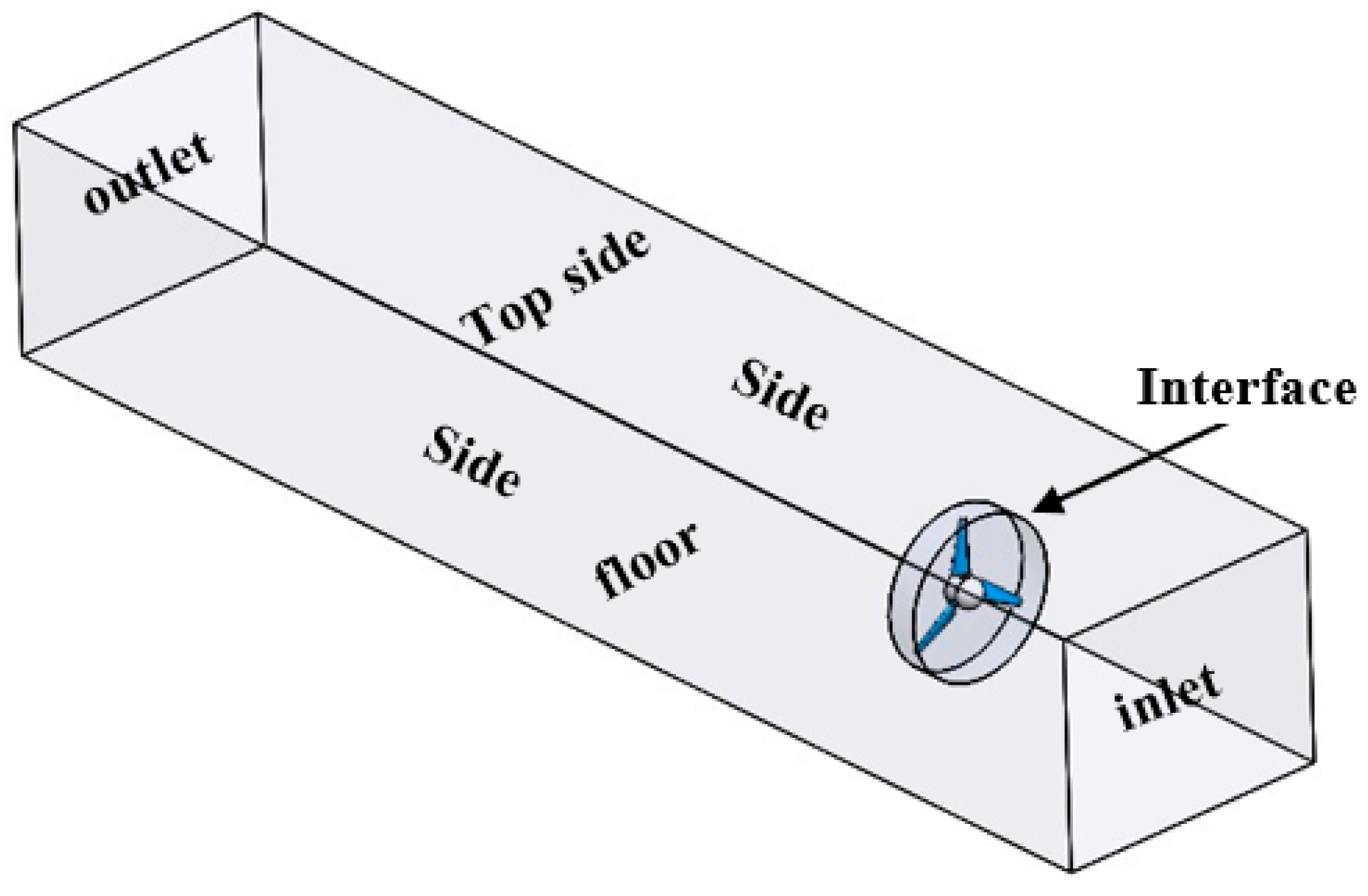
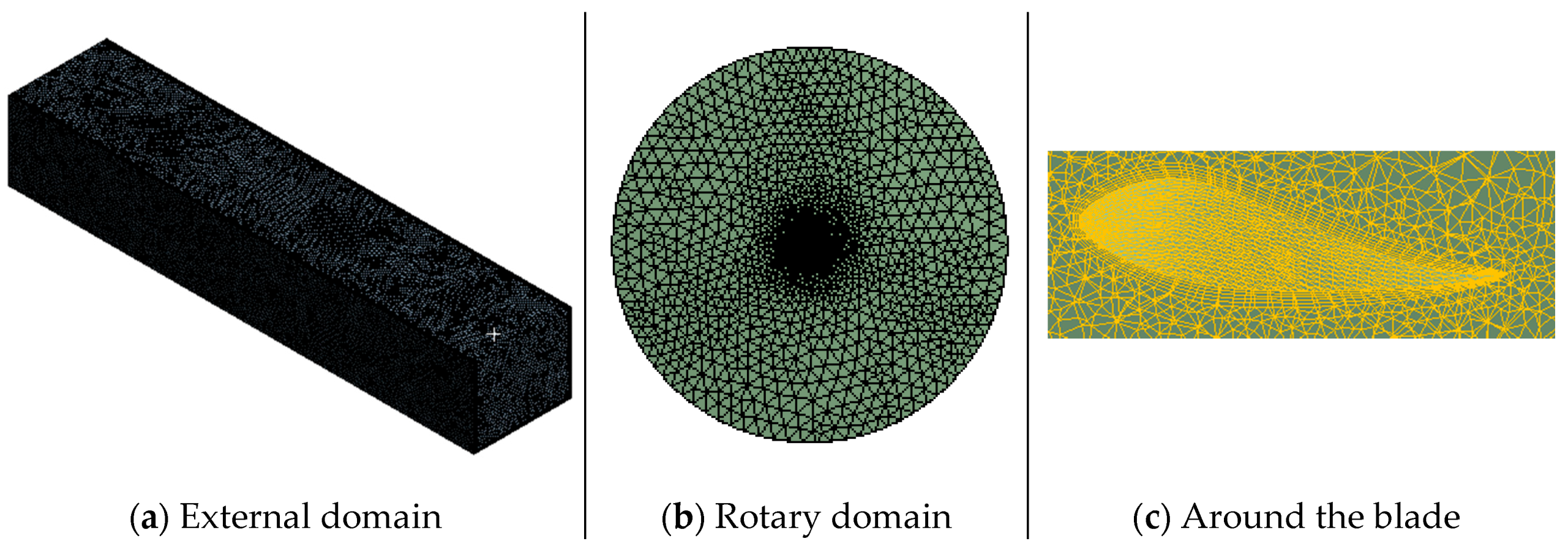
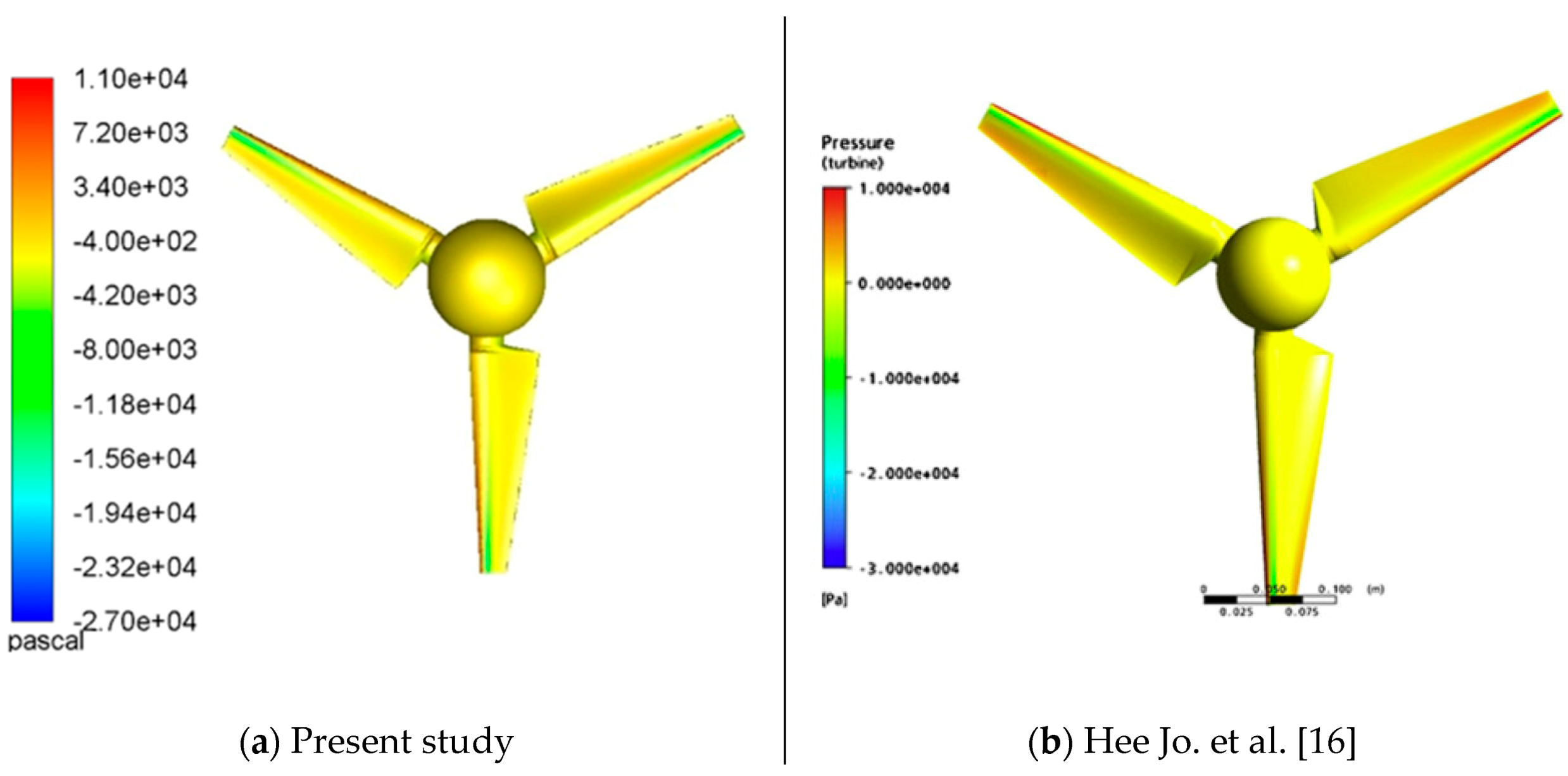
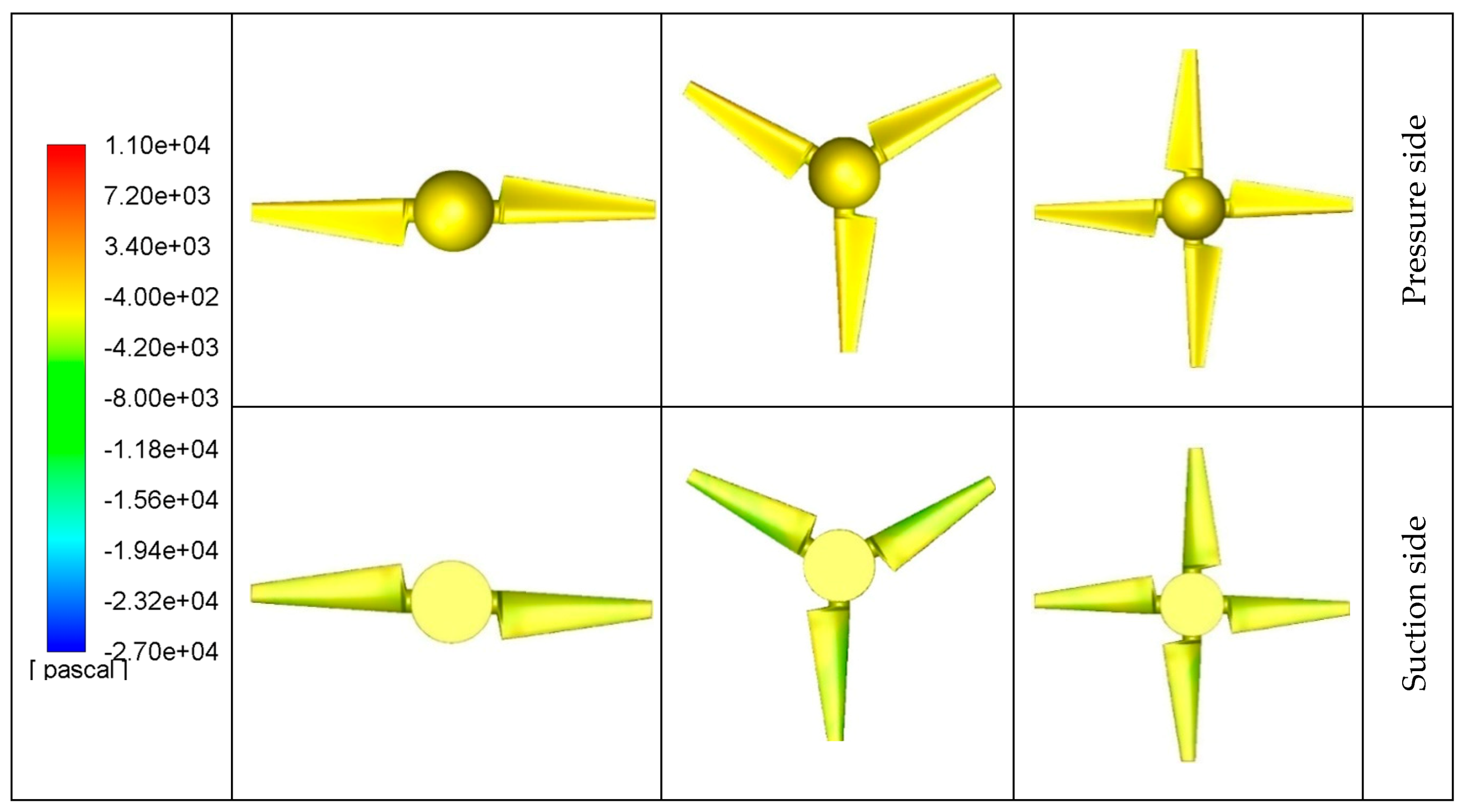
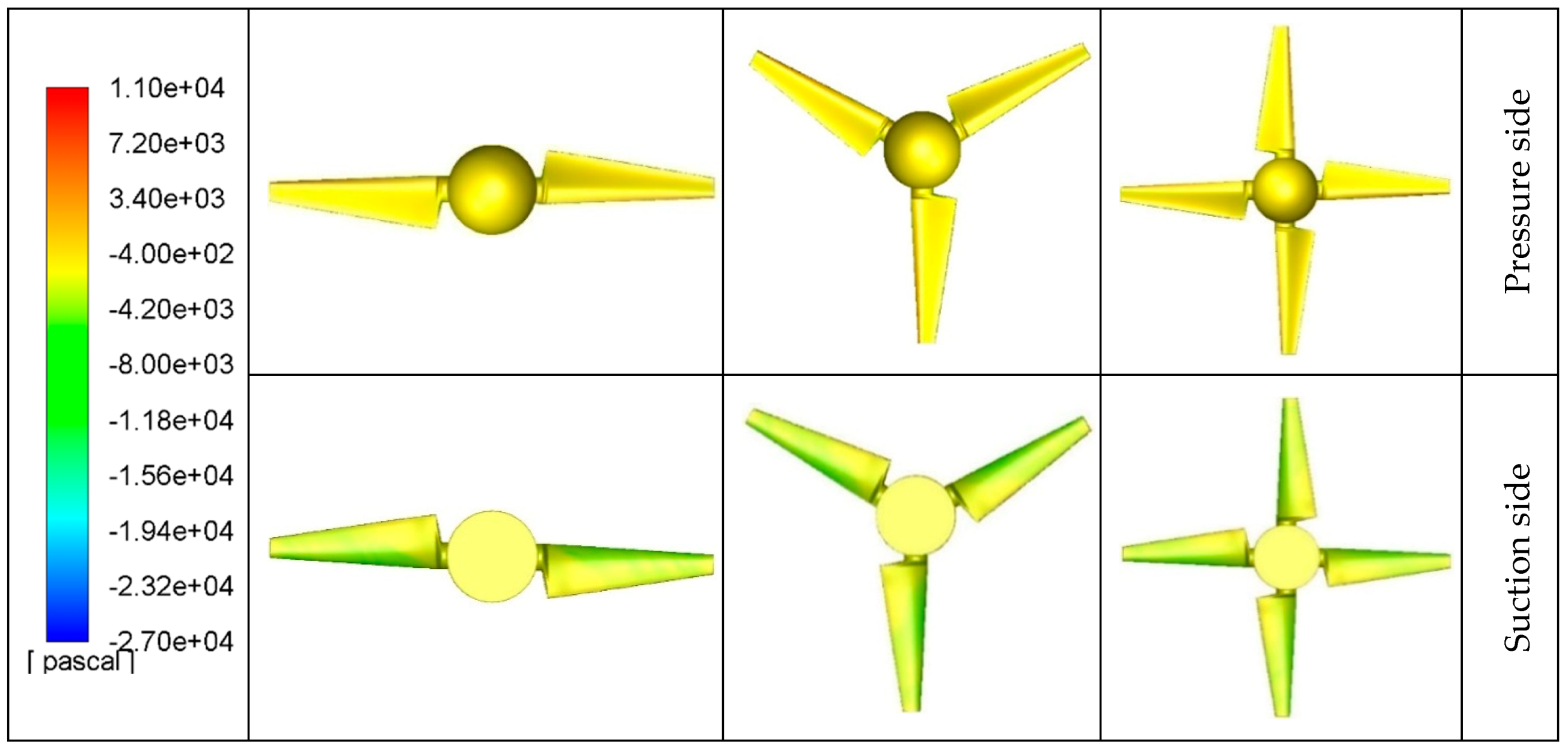

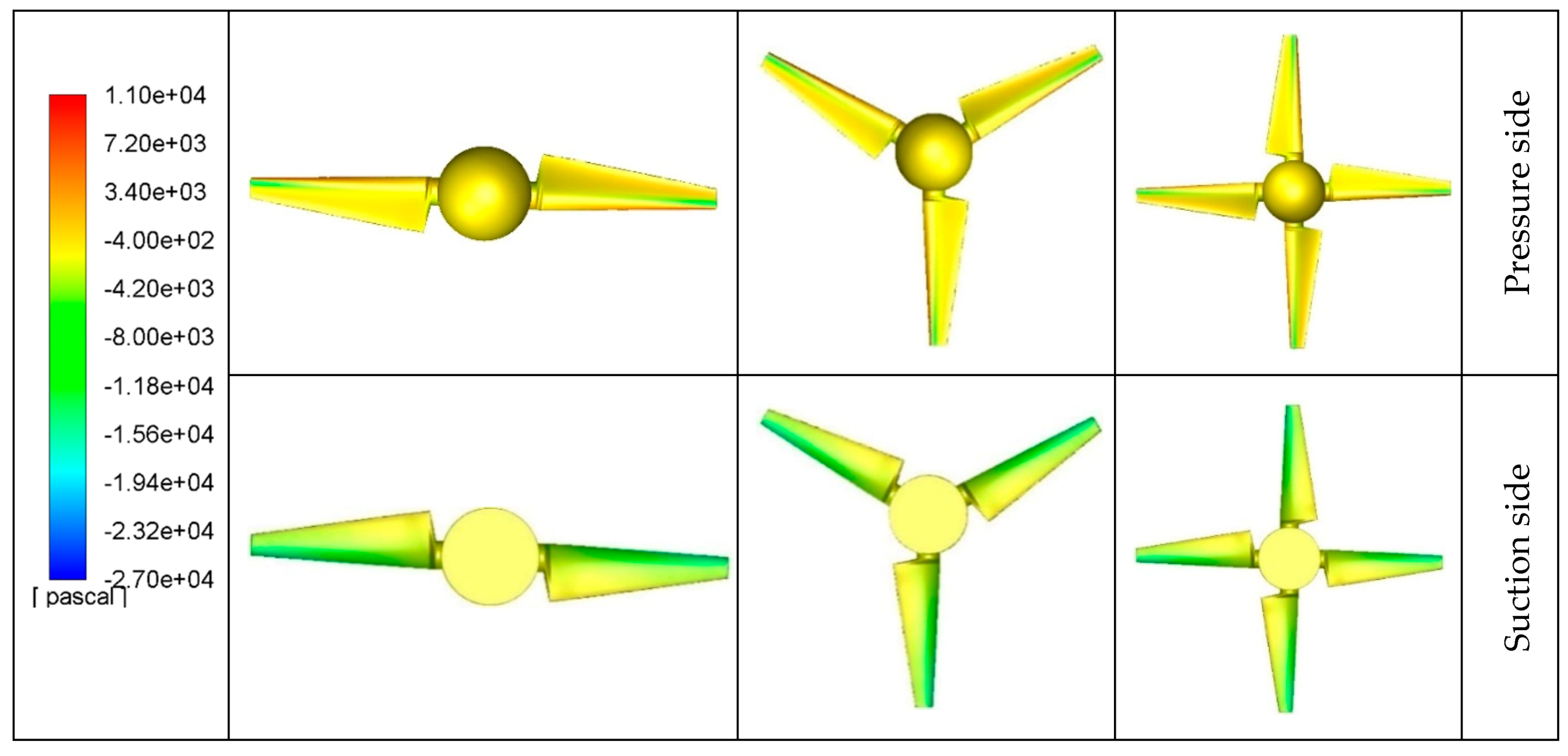
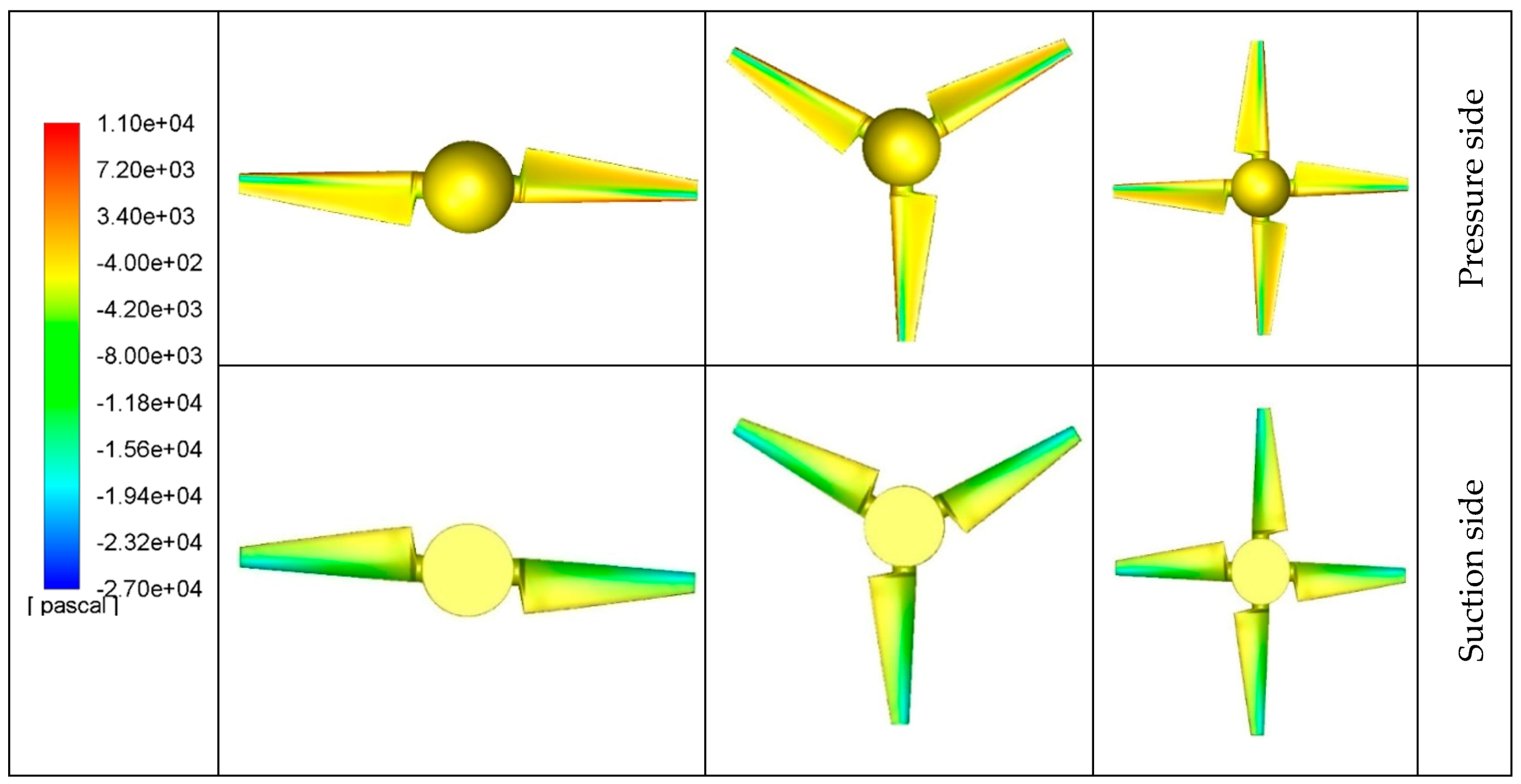
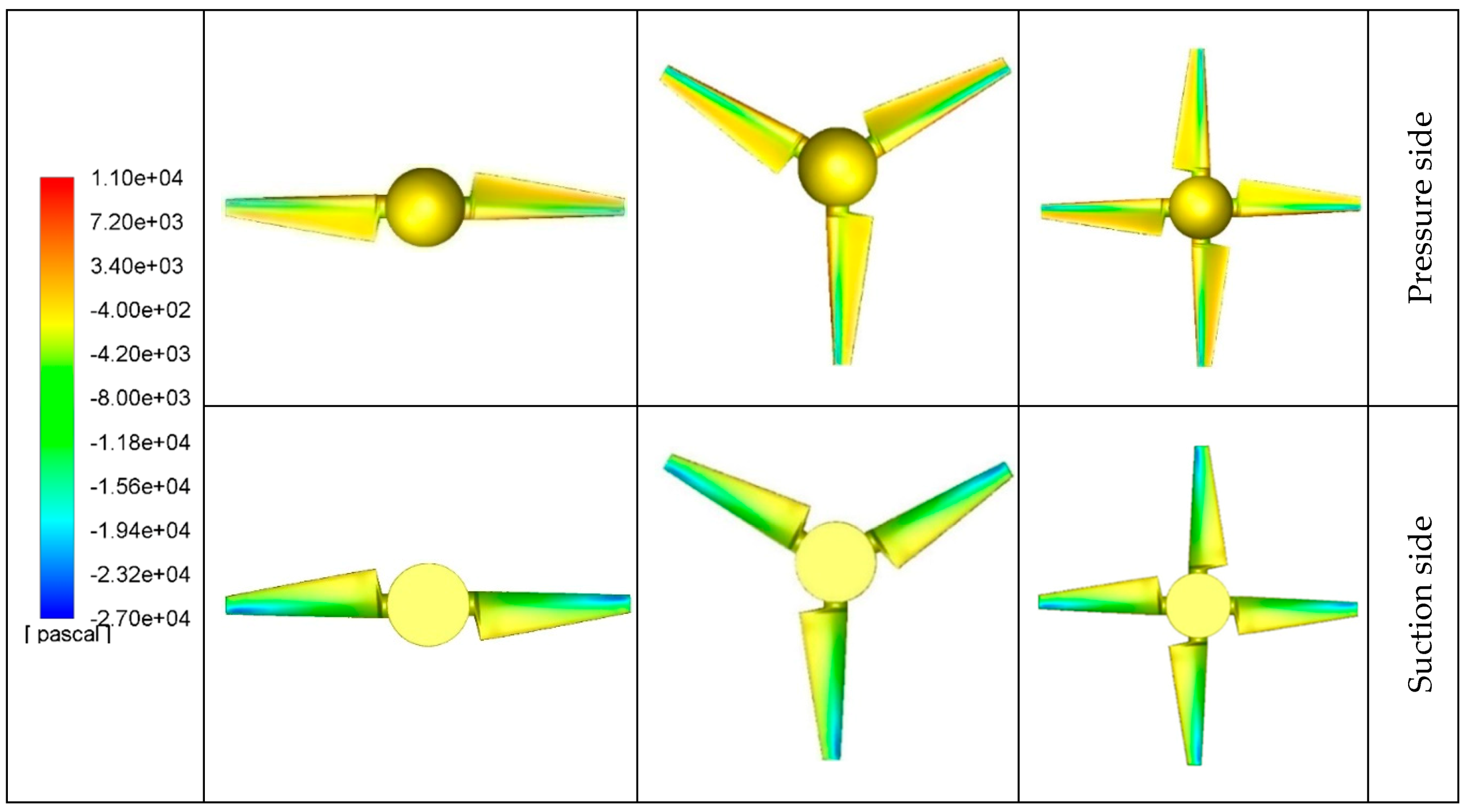
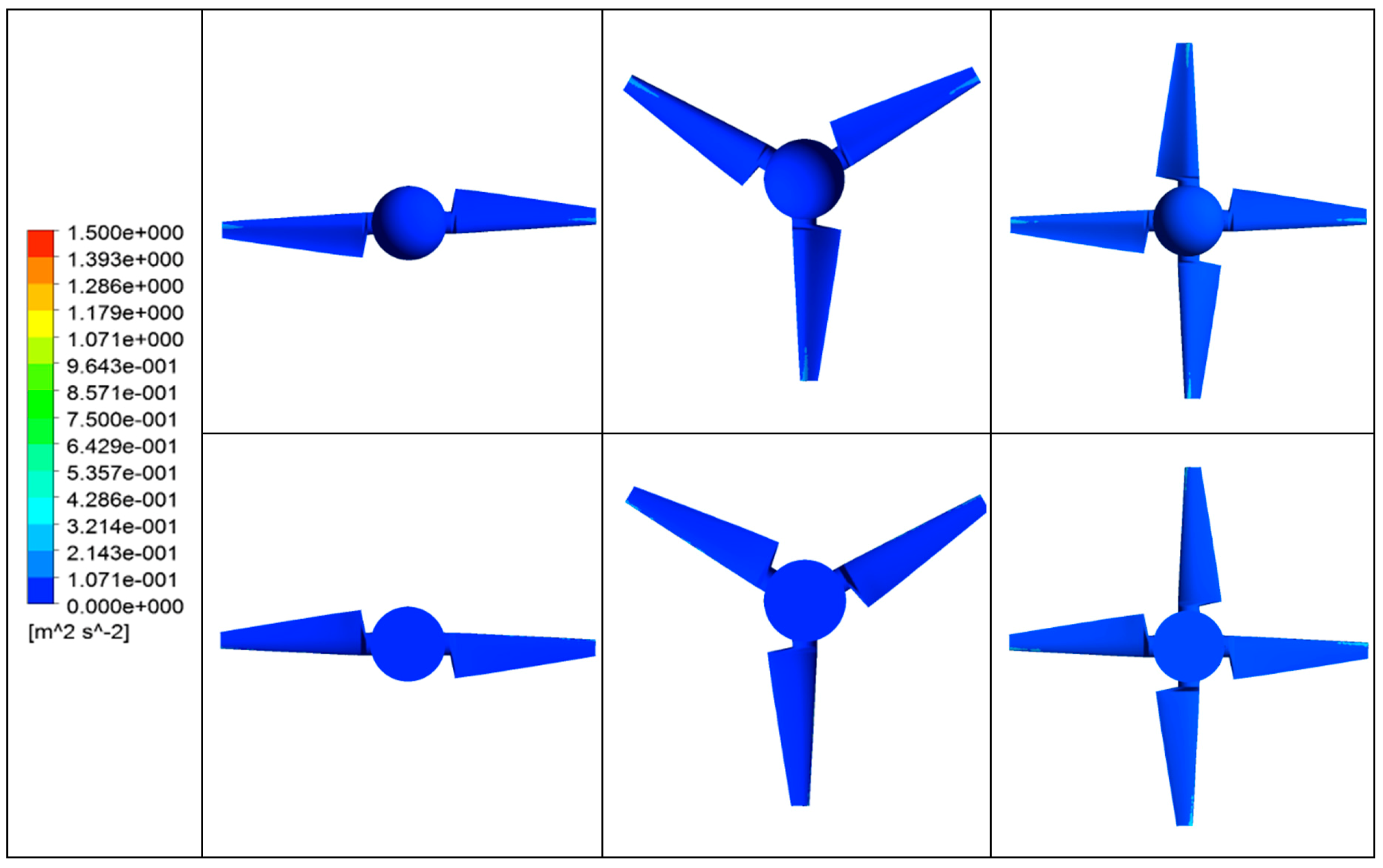
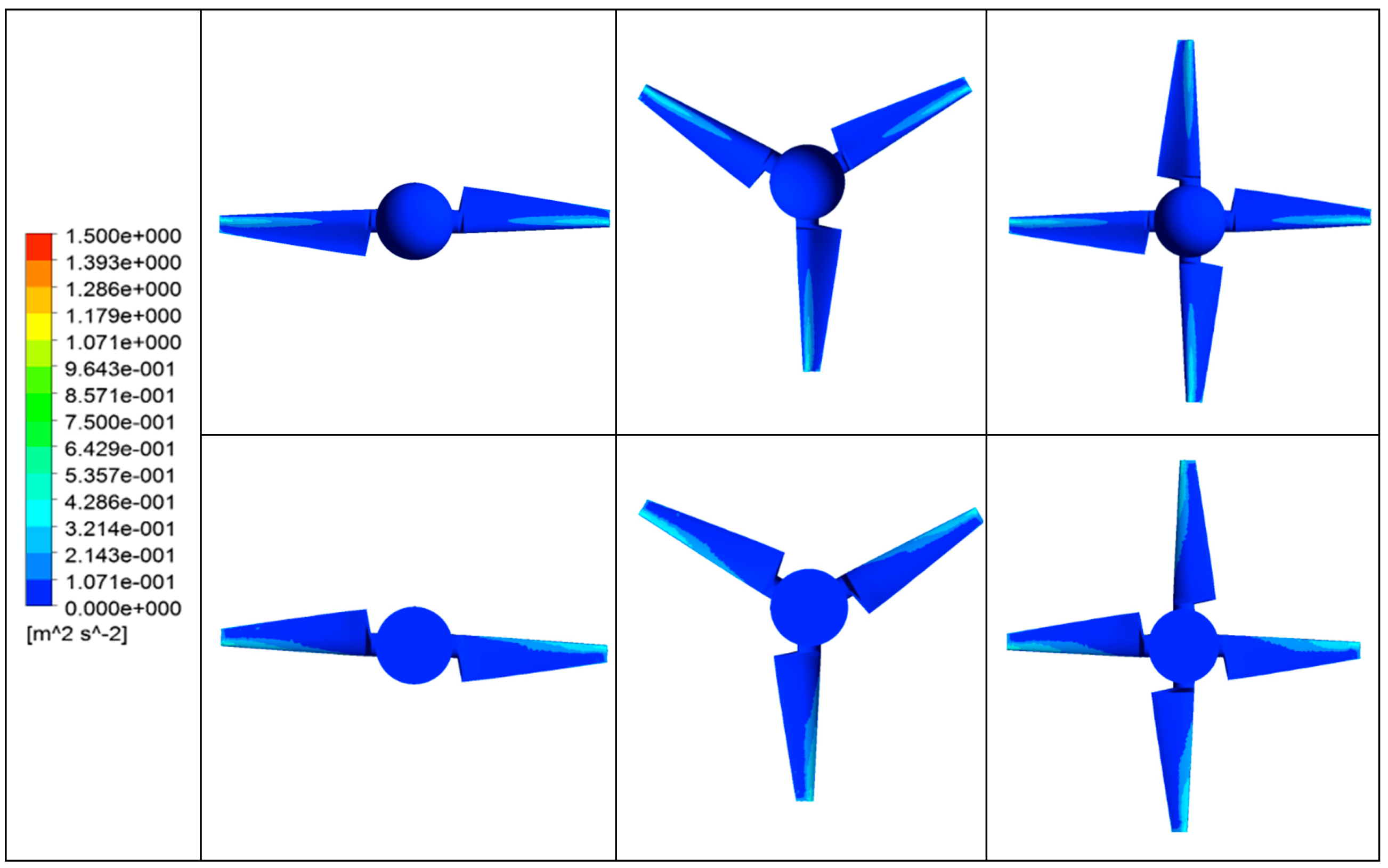
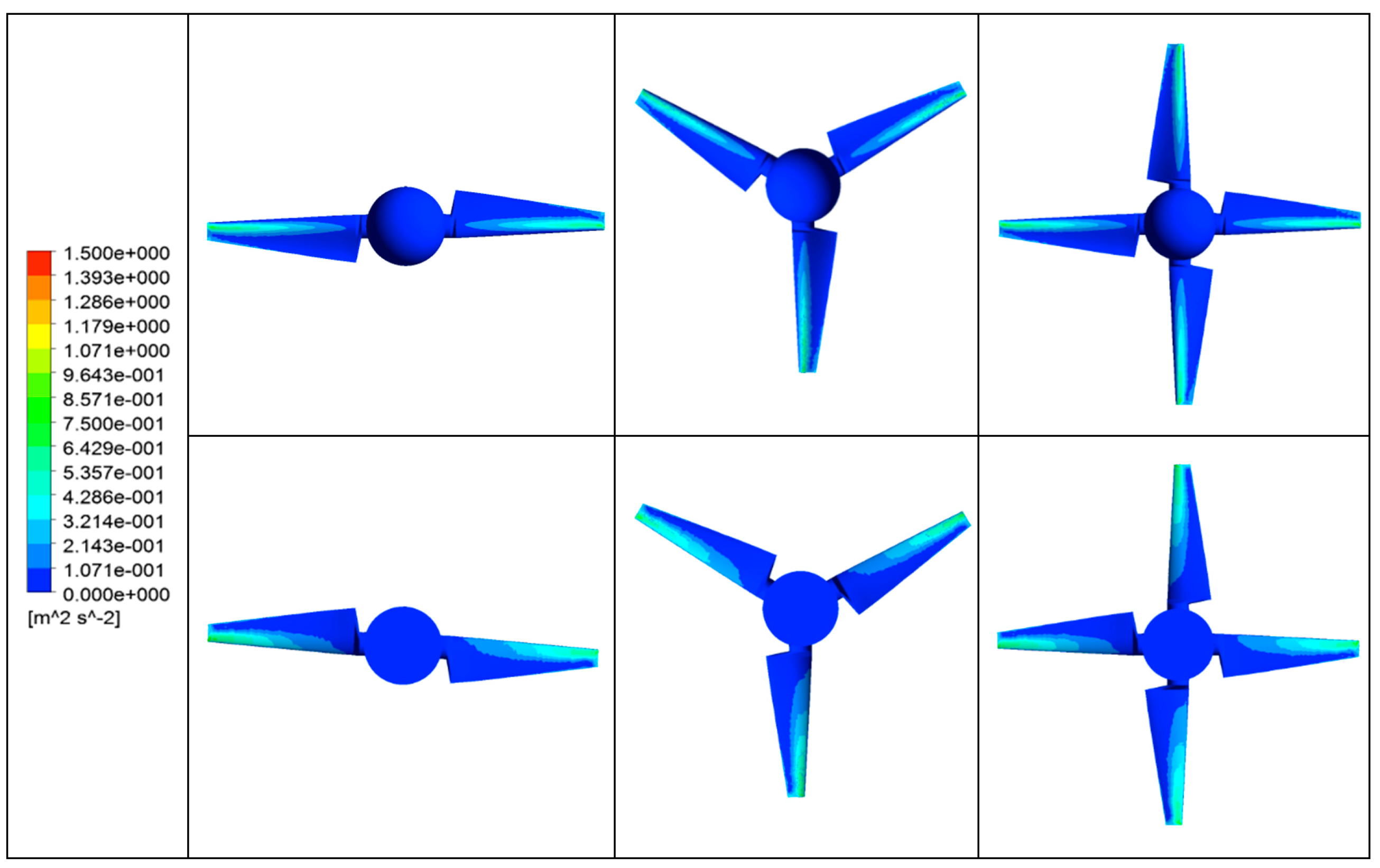
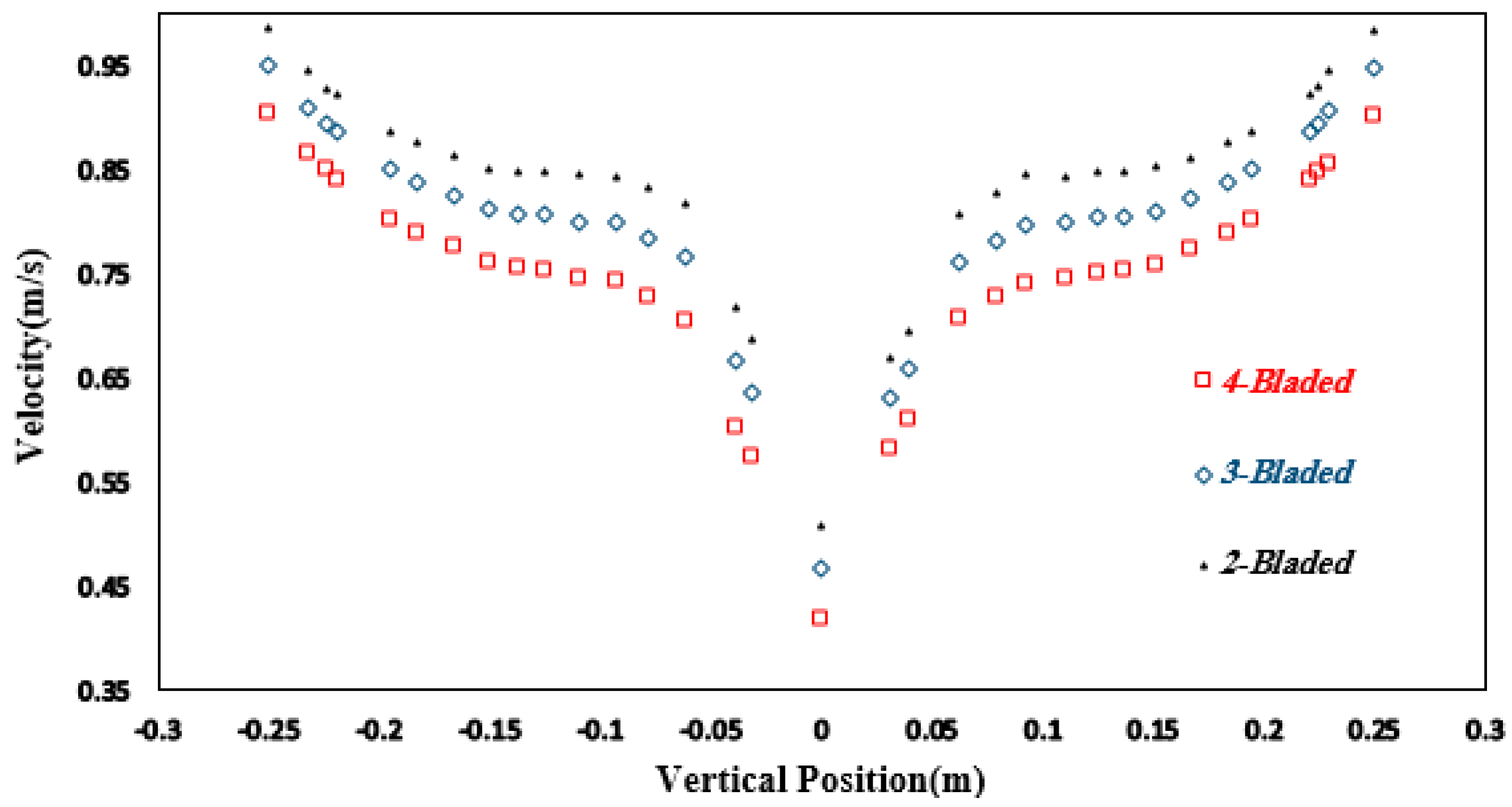

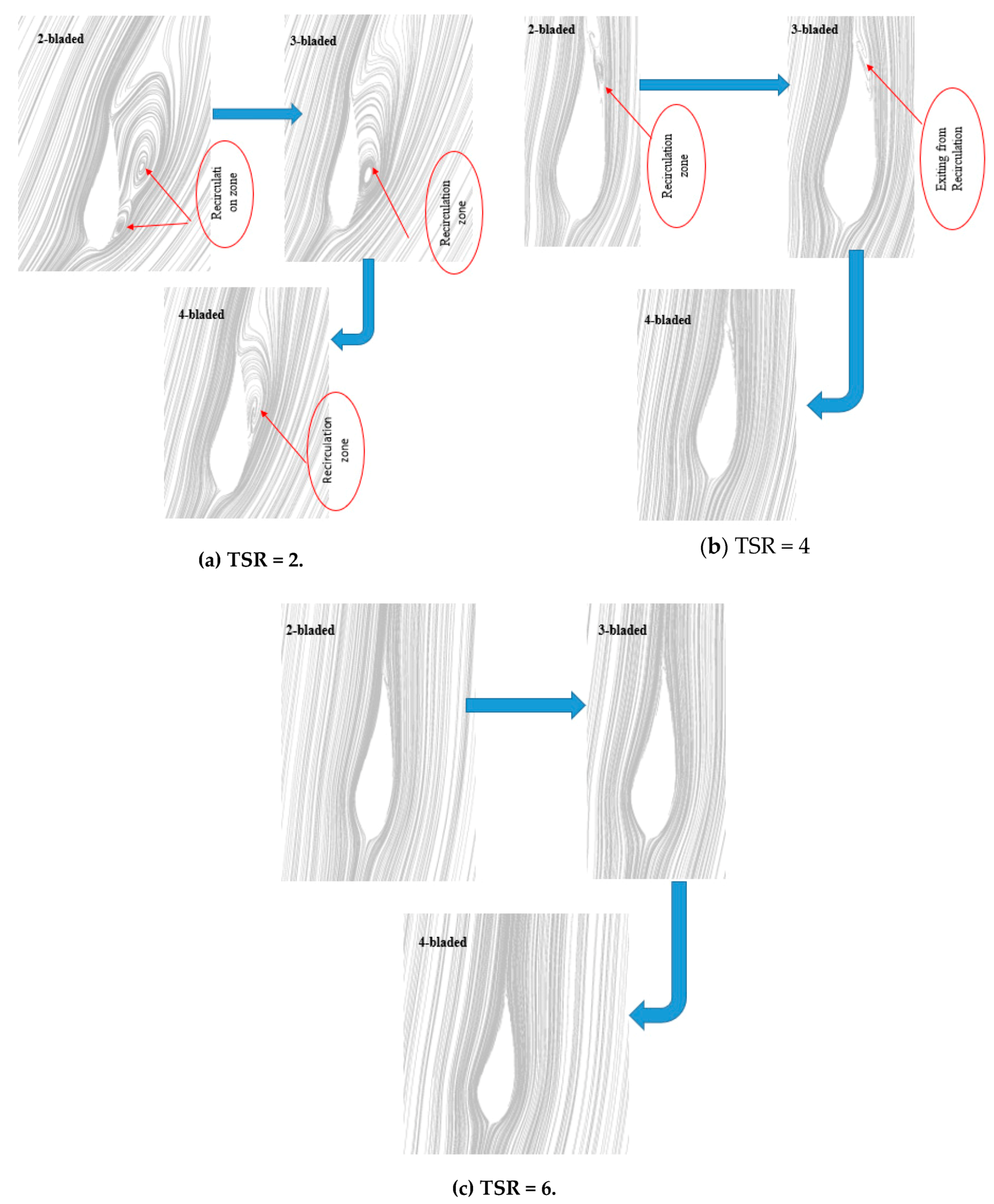

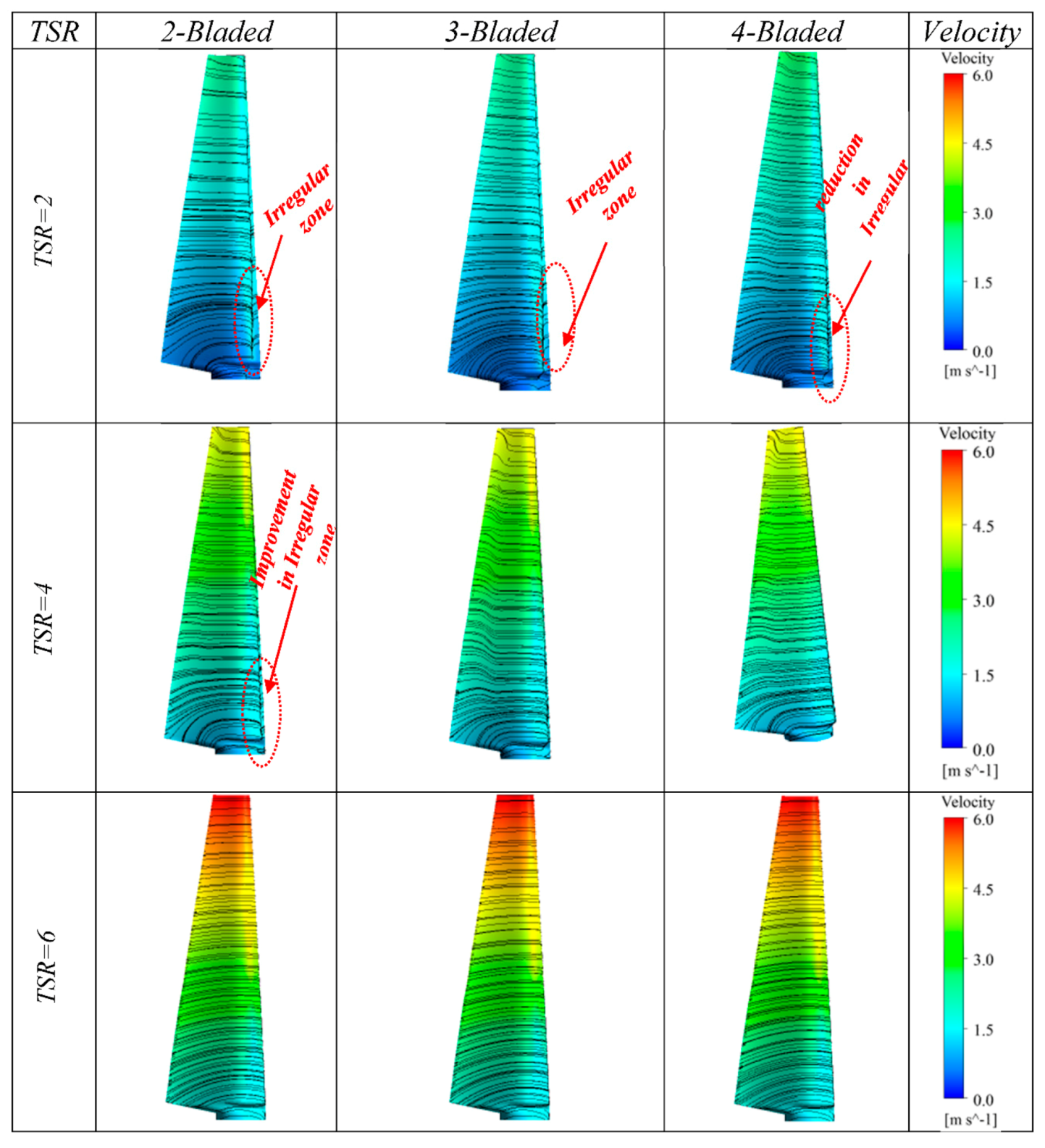
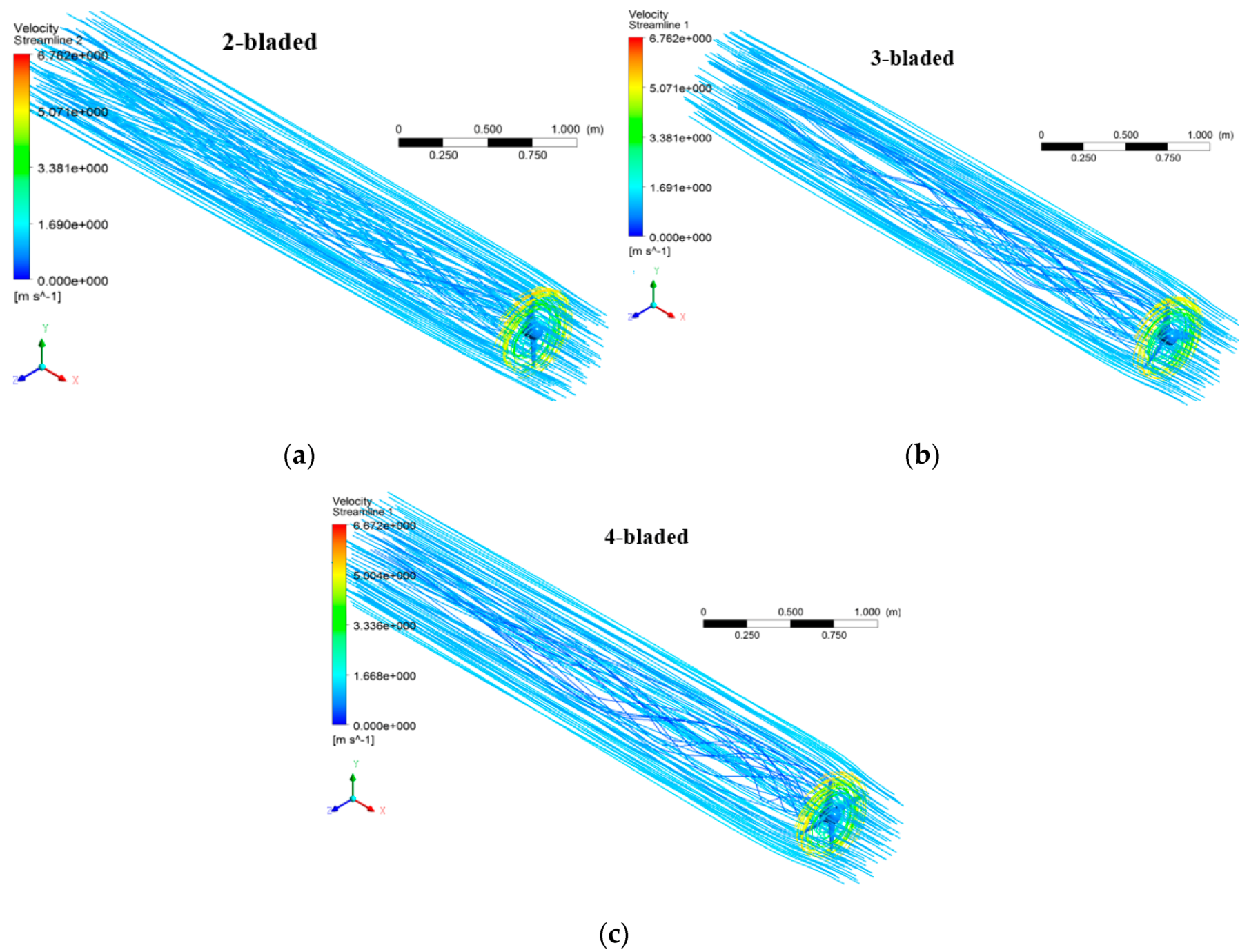
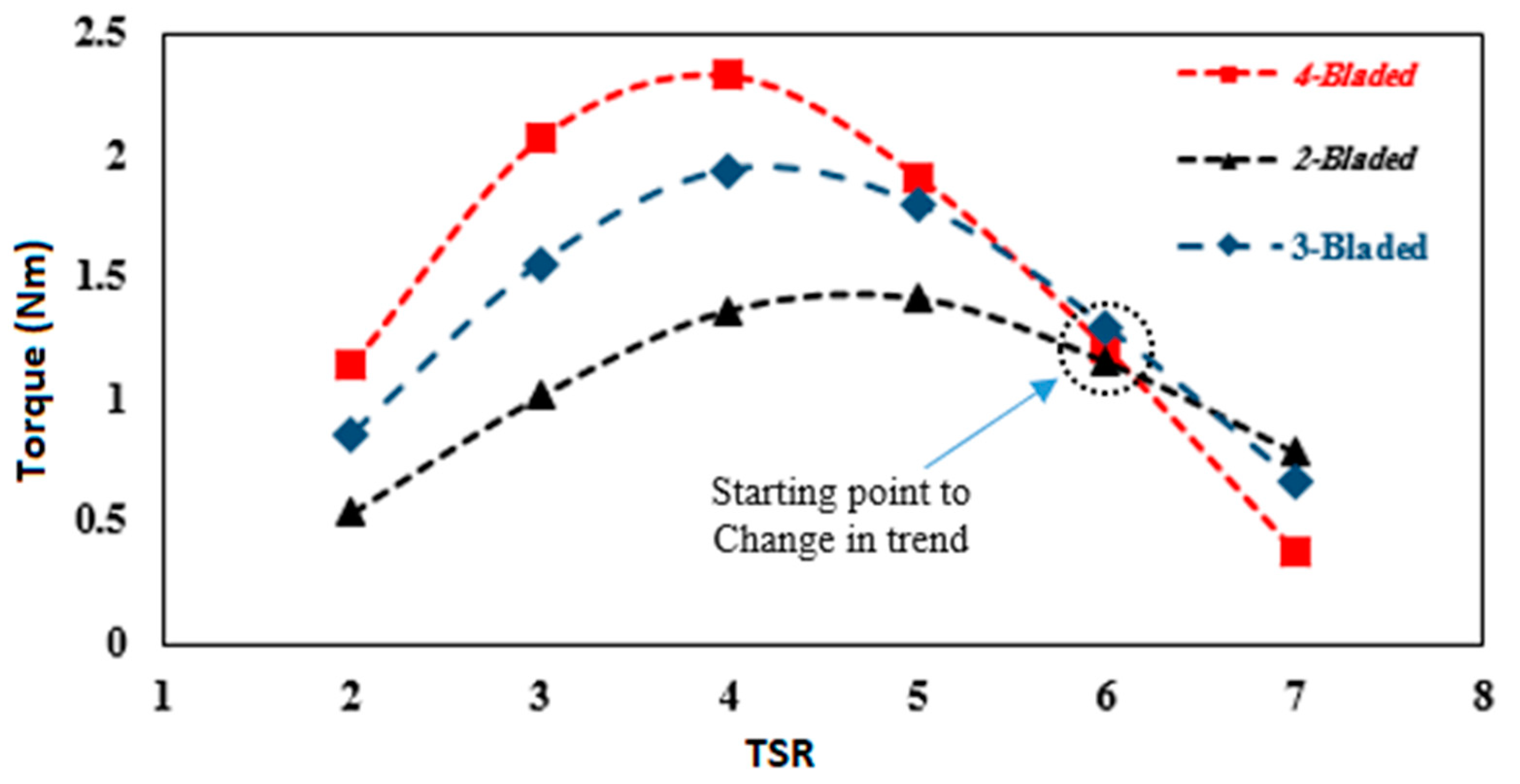
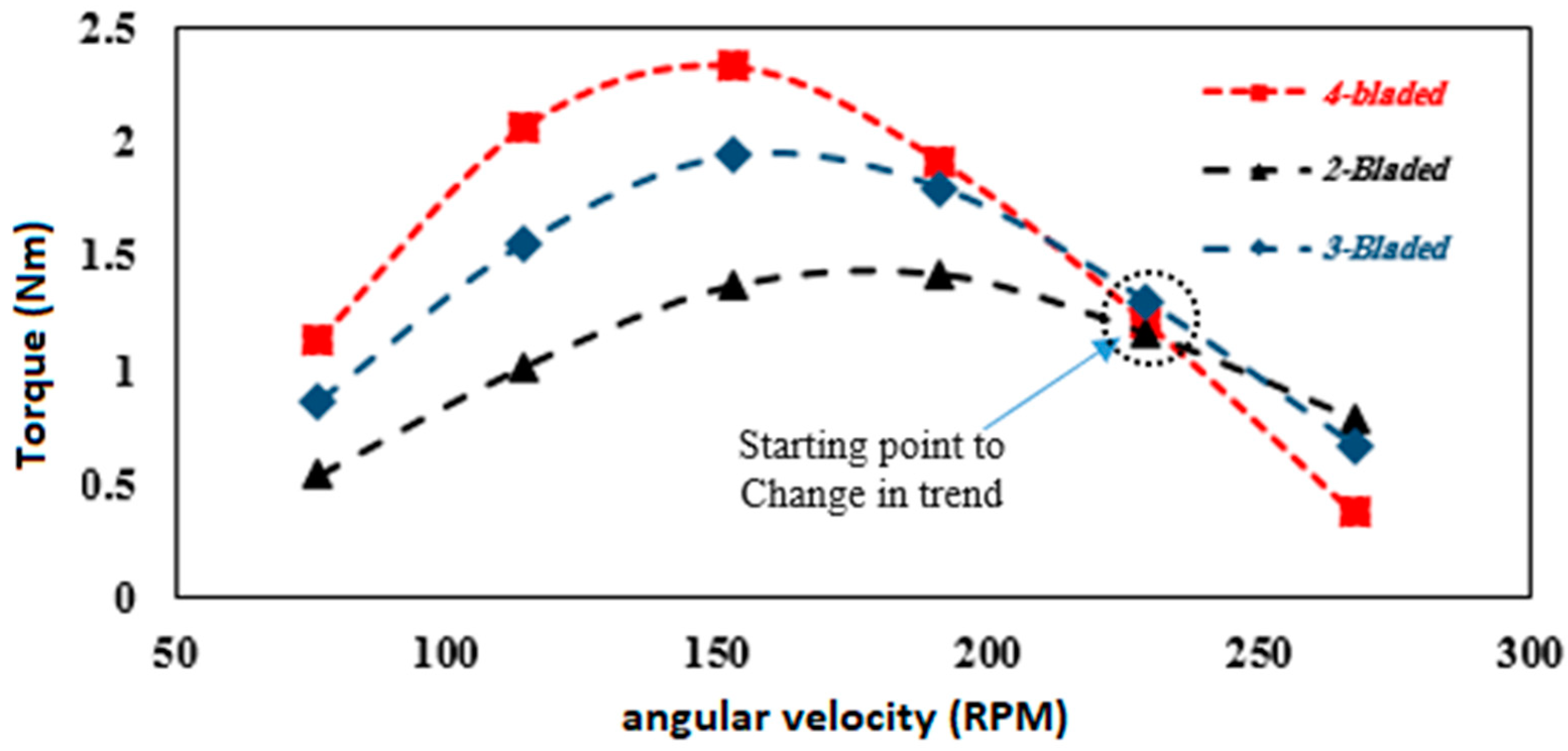
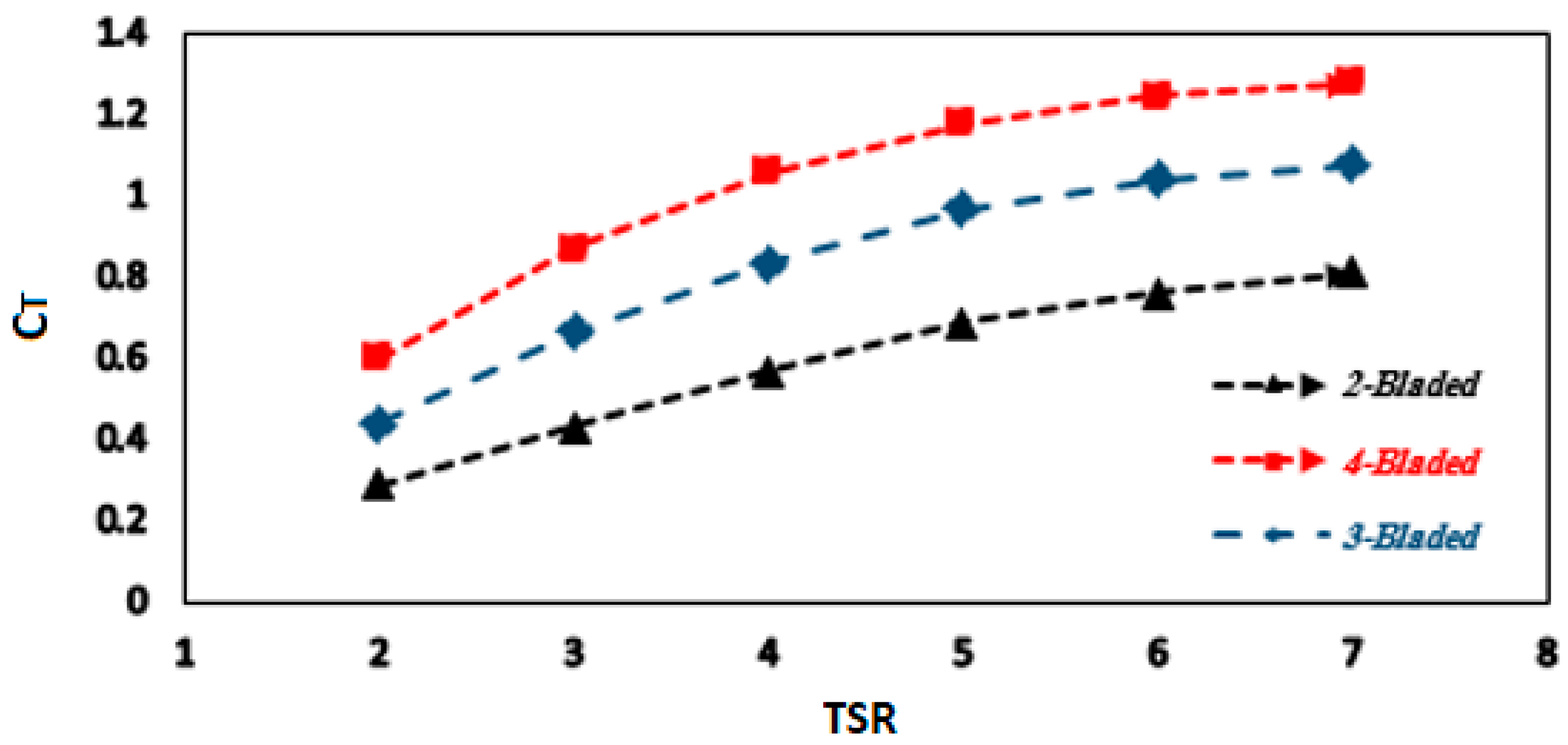
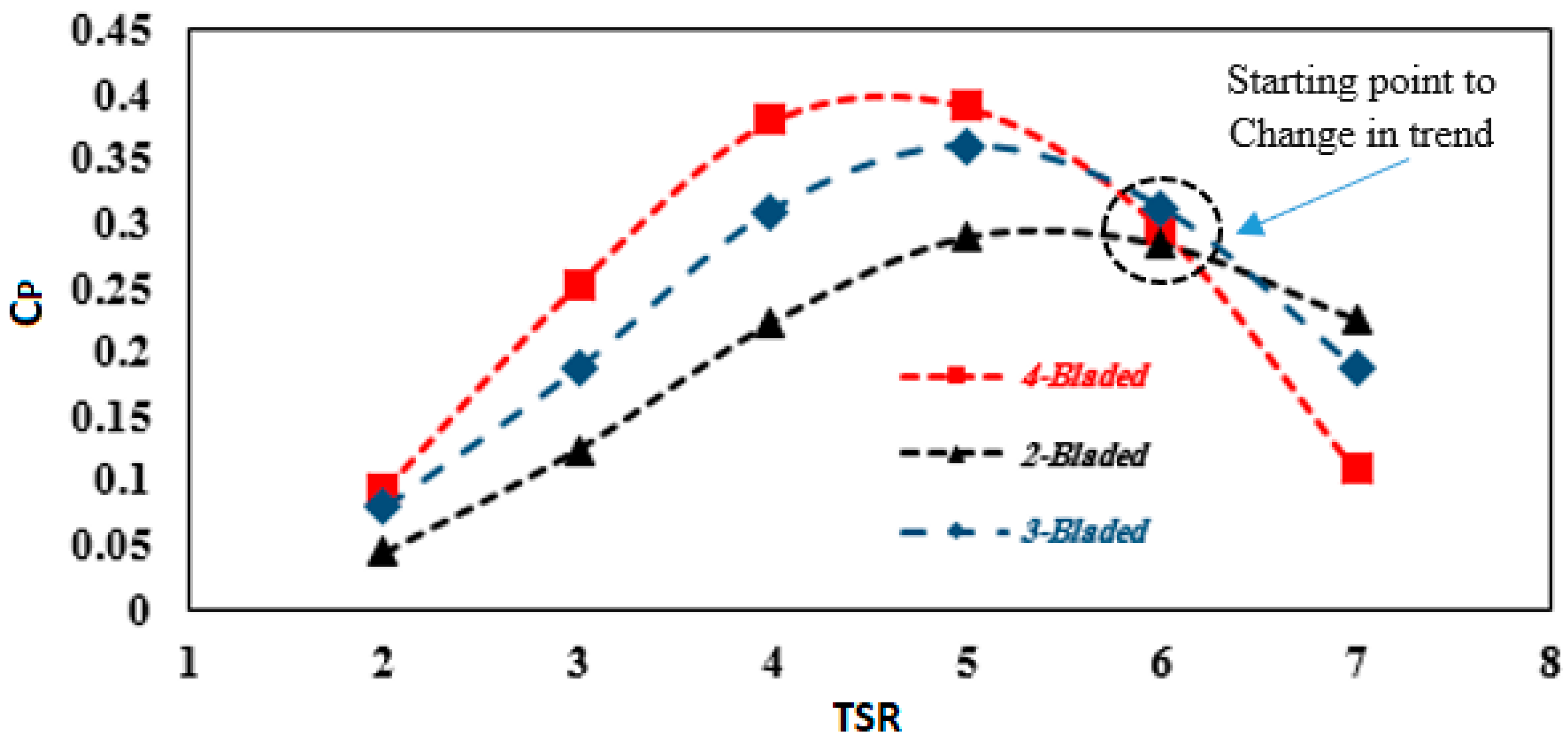
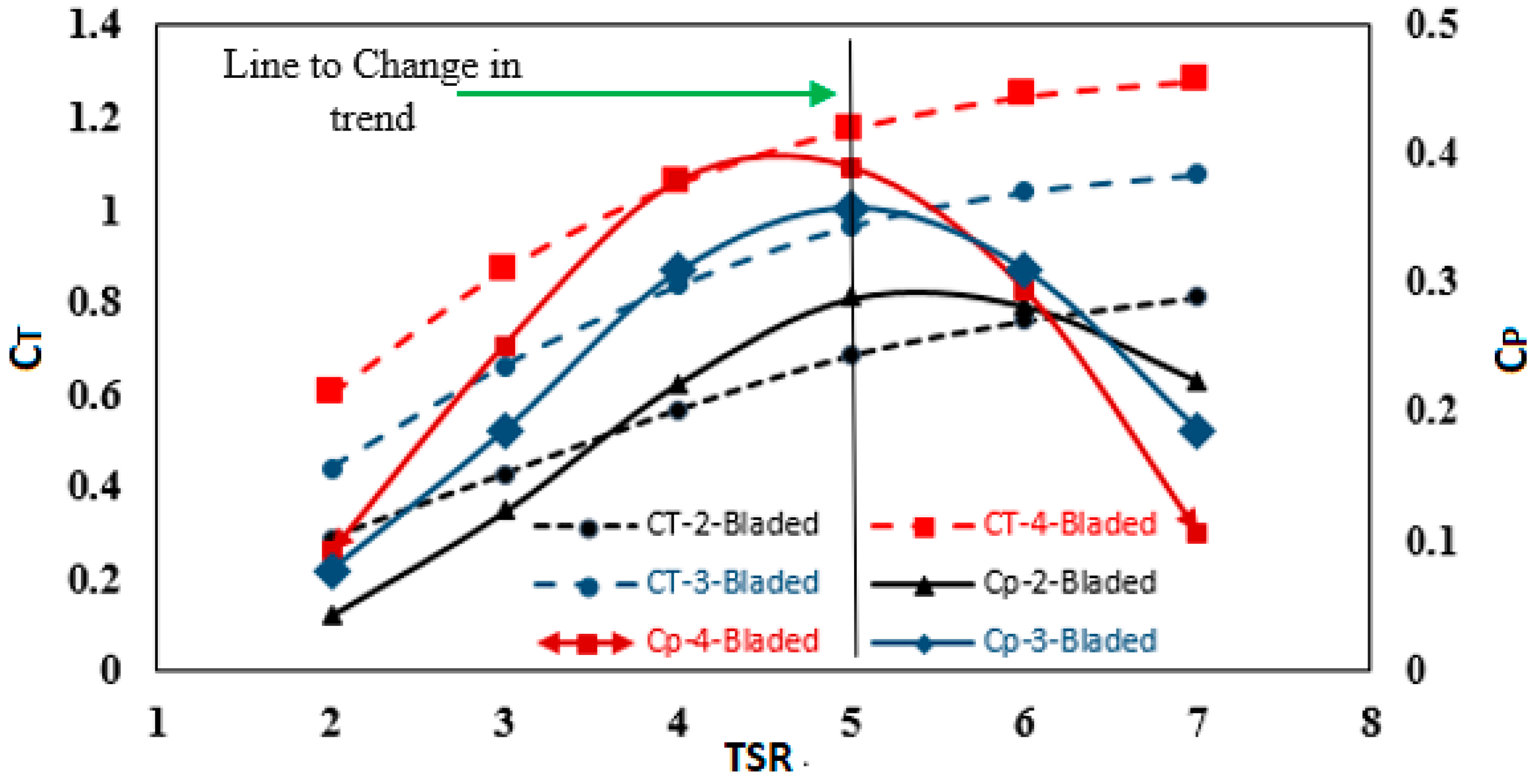
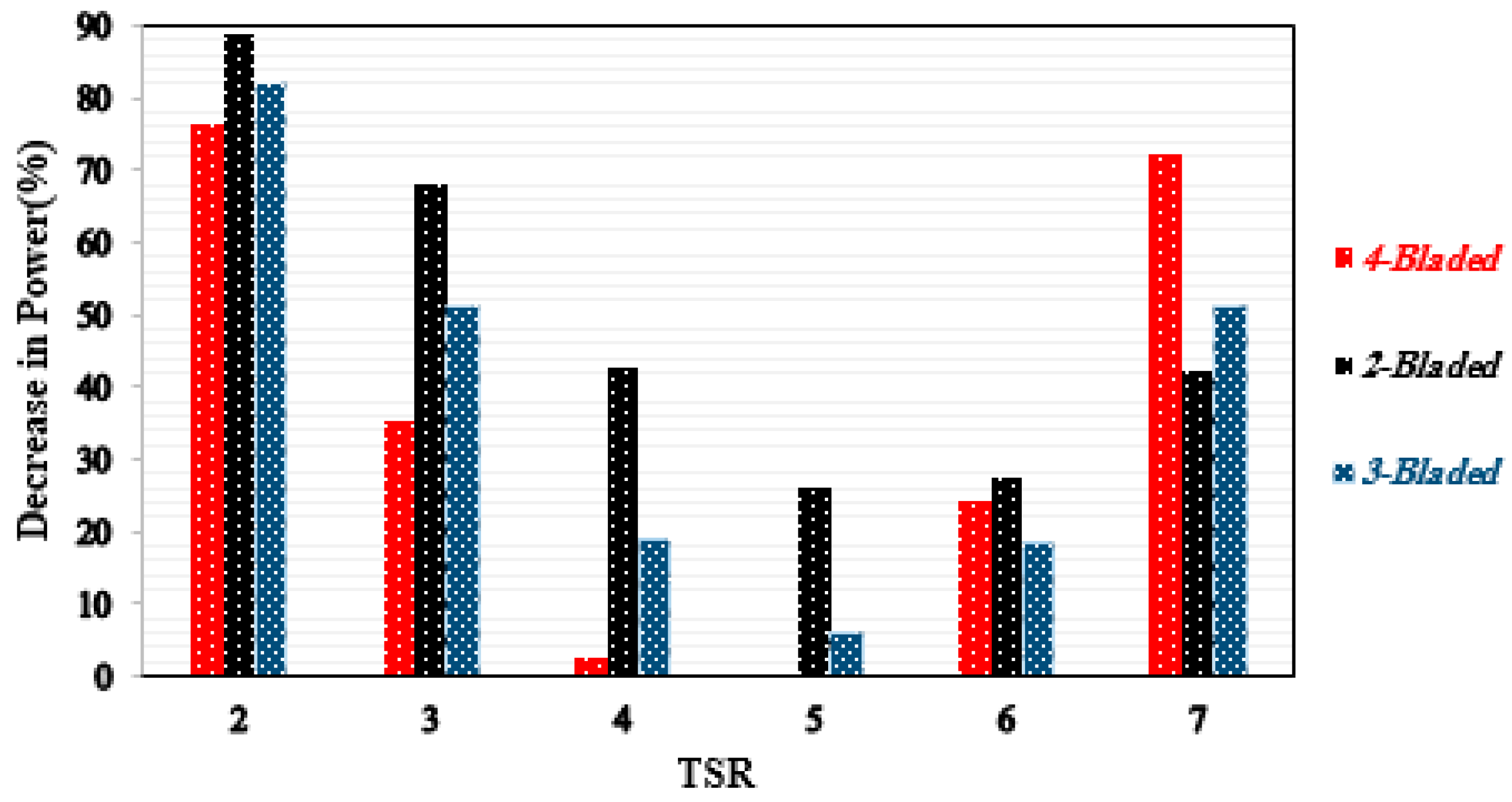
| Element Number | Cp |
|---|---|
| 1043915 | 0.32 |
| 1581331 | 0.34 |
| 2055727 | 0.36 |
| 2672135 | 0.36 |
| Model | Number of Meshes | Number of Grids |
|---|---|---|
| 2-bladed turbine | 1861361 | 367503 |
| 3-bladed turbine | 2055727 | 367503 |
| 4-bladed turbine | 2867242 | 612926 |
| Type of Model | Flume Width (m) | Water Height (m) | Velocity (m/s) | N | D (m) | Ω (rpm) | Cp | Error (%) |
|---|---|---|---|---|---|---|---|---|
| Experimental [16] | 1 | 0.8 | 1 | 3 | 0.5 | 191 | 0.4 | - |
| CFD Model [16] | 1 | 0.8 | 1 | 3 | 0.5 | 191 | 0.51 | 27 |
| CFD Model (present study) | 1 | 0.8 | 1 | 3 | 0.5 | 191 | 0.36 | 10 |
| Experimental [43] | 7 | 3.5 | 1 | 2 | 0.7 | 136.41 | 0.3 | - |
| CFD Model (present study) | 7 | 3.5 | 1 | 2 | 0.7 | 136.41 | 0.268 | 10.6 |
| Research | Blade Number | Diameter (m) | TSR | Velocity (m/s) | CPmax | Type of Study |
|---|---|---|---|---|---|---|
| Jing et al. [43] | 2 | 2.00 | 4.00 | 2.00 | 0.39 | Experimental |
| present study | 2 | 0.50 | 5.00 | 1.00 | 0.29 | Simulation |
| Jing et al. [43] | 2 | 0.70 | 5.00 | 1.50 | 0.33 | Experimental |
| Yan et al. [12] | 3 | 0.80 | --- | 1.50 | 0.41 | Simulation |
| present study | 3 | 0.50 | 5.00 | 1.00 | 0.36 | Simulation |
| Hee jo et al. [16] | 3 | 0.50 | 5.00 | 1.00 | 0.40 | Experimental |
| Tian et al. [54] | 3 | 0.80 | 5.00 | 1.73 | 0.32 | Simulation |
| Tian et al. [59] | 3 | 1.20 | 5.00 | 0.50 | 0.41 | Simulation |
| Kolekar et al. [60] | 3 | 2.00 | 6.36 | 2.00 | 0.52 | Experimental |
| present study | 4 | 0.50 | 5.00 | 1.00 | 0.39 | Simulation |
| Morandi et al. [61] | 6 | 0.40 | 2.25 | 2.76 | 0.39 | Experimental |
© 2020 by the authors. Licensee MDPI, Basel, Switzerland. This article is an open access article distributed under the terms and conditions of the Creative Commons Attribution (CC BY) license (http://creativecommons.org/licenses/by/4.0/).
Share and Cite
Alipour, R.; Alipour, R.; Rahimian Koloor, S.S.; Petrů, M.; Ghazanfari, S.A. On the Performance of Small-Scale Horizontal Axis Tidal Current Turbines. Part 1: One Single Turbine. Sustainability 2020, 12, 5985. https://doi.org/10.3390/su12155985
Alipour R, Alipour R, Rahimian Koloor SS, Petrů M, Ghazanfari SA. On the Performance of Small-Scale Horizontal Axis Tidal Current Turbines. Part 1: One Single Turbine. Sustainability. 2020; 12(15):5985. https://doi.org/10.3390/su12155985
Chicago/Turabian StyleAlipour, Ramin, Roozbeh Alipour, Seyed Saeid Rahimian Koloor, Michal Petrů, and Seyed Alireza Ghazanfari. 2020. "On the Performance of Small-Scale Horizontal Axis Tidal Current Turbines. Part 1: One Single Turbine" Sustainability 12, no. 15: 5985. https://doi.org/10.3390/su12155985
APA StyleAlipour, R., Alipour, R., Rahimian Koloor, S. S., Petrů, M., & Ghazanfari, S. A. (2020). On the Performance of Small-Scale Horizontal Axis Tidal Current Turbines. Part 1: One Single Turbine. Sustainability, 12(15), 5985. https://doi.org/10.3390/su12155985







